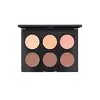What's inside
What's inside
 Key Ingredients
Key Ingredients

 Benefits
Benefits

 Concerns
Concerns

 Ingredients Side-by-side
Ingredients Side-by-side

Talc
AbrasiveNylon-12
Boron Nitride
AbsorbentAluminum Starch Octenylsuccinate
AbsorbentEthyl Macadamiate
Skin ConditioningDimethicone
EmollientMagnesium Myristate
Synthetic Fluorphlogopite
Phenoxyethanol
PreservativeTrimethylsiloxysilicate
EmollientLauroyl Lysine
Skin ConditioningCaprylyl Glycol
EmollientPolybutene
Hexylene Glycol
EmulsifyingEthylhexylglycerin
Skin ConditioningWater
Skin ConditioningTocopherol
AntioxidantO-Cymen-5-Ol
AntimicrobialTriethoxycaprylylsilane
Aluminum Hydroxide
EmollientCI 77007
Cosmetic ColorantCI 77891
Cosmetic ColorantCI 15850
Cosmetic ColorantMica
Cosmetic ColorantCI 77491
Cosmetic ColorantCI 77492
Cosmetic ColorantCI 77499
Cosmetic ColorantTalc, Nylon-12, Boron Nitride, Aluminum Starch Octenylsuccinate, Ethyl Macadamiate, Dimethicone, Magnesium Myristate, Synthetic Fluorphlogopite, Phenoxyethanol, Trimethylsiloxysilicate, Lauroyl Lysine, Caprylyl Glycol, Polybutene, Hexylene Glycol, Ethylhexylglycerin, Water, Tocopherol, O-Cymen-5-Ol, Triethoxycaprylylsilane, Aluminum Hydroxide, CI 77007, CI 77891, CI 15850, Mica, CI 77491, CI 77492, CI 77499
Talc
AbrasiveNylon-12
Octyldodecyl Stearoyl Stearate
EmollientZinc Stearate
Cosmetic ColorantIsostearyl Neopentanoate
EmollientAscorbyl Palmitate
AntioxidantTocopheryl Acetate
AntioxidantHordeum Vulgare Extract
EmollientTriticum Vulgare Germ Extract
Skin ConditioningSqualane
EmollientTin Oxide
AbrasiveCaprylyl Glycol
EmollientMagnesium Myristate
Hexylene Glycol
EmulsifyingPhenoxyethanol
PreservativeMica
Cosmetic ColorantCI 77891
Cosmetic ColorantIron Oxides
CI 75470
Cosmetic ColorantCI 15850
Cosmetic ColorantCI 77007
Cosmetic ColorantCI 19140
Cosmetic ColorantTalc, Nylon-12, Octyldodecyl Stearoyl Stearate, Zinc Stearate, Isostearyl Neopentanoate, Ascorbyl Palmitate, Tocopheryl Acetate, Hordeum Vulgare Extract, Triticum Vulgare Germ Extract, Squalane, Tin Oxide, Caprylyl Glycol, Magnesium Myristate, Hexylene Glycol, Phenoxyethanol, Mica, CI 77891, Iron Oxides, CI 75470, CI 15850, CI 77007, CI 19140
 Reviews
Reviews

Ingredients Explained
These ingredients are found in both products.
Ingredients higher up in an ingredient list are typically present in a larger amount.
Caprylyl Glycol is a humectant and emollient, meaning it attracts and preserves moisture.
It is a common ingredient in many products, especially those designed to hydrate skin. The primary benefits are retaining moisture, skin softening, and promoting a healthy skin barrier.
Though Caprylyl Glycol is an alcohol derived from fatty acids, it is not the kind that can dry out skin.
This ingredient is also used as a preservative to extend the life of products. It has slight antimicrobial properties.
Learn more about Caprylyl GlycolCi 15850 is the pigment color red. It is an azo dye and created synthetically.
Azo dyes need to be thoroughly purified before use. This allows them to be more stable and longer-lasting.
This ingredient is common in foundations, lipsticks, and blushes. This color is described as brown/orangey red.
It has many secondary names such as Red 6 and Red 7. According to a manufacturer, Red 6 usually contains aluminum.
Learn more about CI 15850This pigment is called Ultramarine blue lazurite. It gives a saturated blue color, but can be used to create other colors as well.
According to the manufacturer, it is usually made from kaolin, sodium sulfate, sodium carbonate, sulfur, and charcoal.
Ci 77891 is a white pigment from Titanium dioxide. It is naturally found in minerals such as rutile and ilmenite.
It's main function is to add a white color to cosmetics. It can also be mixed with other colors to create different shades.
Ci 77891 is commonly found in sunscreens due to its ability to block UV rays.
Learn more about CI 77891Hexylene Glycol is a surfactant. Glycols are a class of alcohols. Hexylene Glycol is a surfactant and emulsifier.
As a surfactant, Hexylene Glycol helps gather dirt and oil on your skin to be washed away.
As an emulsifier, Hexylene Glycol helps keep water and oil together. This prevents them from separating in a product. Hexylene Glycol also thins out the texture of a product by lessening viscosity.
Hexylene Glycol has a small molecular weight.
Learn more about Hexylene GlycolWe don't have a description for Magnesium Myristate yet.
Mica is a naturally occurring mineral used to add shimmer and color in cosmetics. It can also help improve the texture of a product or give it an opaque, white/silver color.
Serecite is the name for very fine but ragged grains of mica.
This ingredient is often coated with metal oxides like titanium dioxide. Trace amounts of heavy metals may be found in mica, but these metals are not harmful in our personal products.
Mica has been used since prehistoric times throughout the world. Ancient Egyptian, Indian, Greek, Roman, Aztec, and Chinese civilizations have used mica.
Learn more about MicaNylon-12 is a polymer. It is derived from 12-aminododecanoic acid, an omega-amino fatty acid
According to a manufacturer, it is a talc substitute. Like talc, nylon-12 gives products a satin feel. The manufacturer also claims this ingredients does not block pores and has moderate oil absorption.
This ingredient may not be reef-safe.
Learn more about Nylon-12Phenoxyethanol is a preservative that has germicide, antimicrobial, and aromatic properties. Studies show that phenoxyethanol can prevent microbial growth. By itself, it has a scent that is similar to that of a rose.
It's often used in formulations along with Caprylyl Glycol to preserve the shelf life of products.
Talc is a clay mineral. It helps absorb moisture and improve the texture of products. Like other types of clay, Talc can have a slight exfoliating effect on skin. Talc can be added to increase the volume of products.
Some Baby powders are made by combining talc with corn starch. The word "talc" comes from Latin and originates from Arabic. Talc is a mineral commonly found throughout the world.
If you have any concerns about using talc, we recommend checking out the FDA's official page.
Learn more about Talc